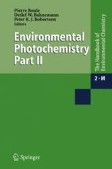Search
Search Results
-
Natural and Artificial Radioactivity in the Rhine and Its Tributaries
Presently, natural and artificial radioactivity in the Rhine River does not present a radiological hazard to the population. On the contrary, the...
-
Early Warning Strategies and Practices Along the River Rhine
In 1986, the International Commission for the Protection of the Rhine (ICPR) installed a Warning and Alarm Plan (WAP) in order to avert the dangers...
-
Pharmaceuticals in the River Rhine
Pharmaceuticals are introduced into the River Rhine mainly via wastewater and can be detected almost permanently in mixed samples taken over the...
-
Pollutants as Byproducts and Degradation Products of Chemical Syntheses
Byproducts of industrial organic syntheses are emitted with the wastewater into the River Rhine; in many cases they are polar and poorly...
-
Water Quality of Lake Constance
Lake Constance is used as a drinking water reservoir for about 5 million people. Because of its glacial origin from the Alps, the amount of...
-
Hydrology
The River Rhine is one of the major rivers of Europe -#8211; the only river that connects the Alps with the North Sea. It flows 1320 km from two...
-
Assessment of Organic Compounds in the Rhine Estuary
Over the past centuries the Rhine estuary has changed from a natural, hardly disturbed estuary into an anthropogenetically influenced area that...
-
Reactions Induced in Natural Waters by Irradiation of Nitrate and Nitrite Ions
This review describes the reaction mechanisms of nitrate and nitrite ions, which play a role in the photochemical processes occurring in natural...
-
The Applications of Photocatalytic Waste Minimisation in Nuclear Fuel Processing
Nuclear fuel processing has two main waste management requirements: (1) the disposal of waste organic solvent (secondary waste) generated by...
-
Effects of Multi-Scale Heterogeneity
It is generally agreed that problems with multi-scale heterogeneity present the biggest challenge to computation and understanding. A few such...
-
Applications of the Correlation Length
The correlation length is the system–dependent parameter, which defines the structure of the dominant current–carrying (electric or fluid) paths....
-
Pressure Saturation Curves and the Critical Volume Fraction for Percolation
The pressure-saturation curves of porous media give fundamental information about the pore space. In equilibrium, ignoring effects due to hysteresis,...
-
Occurrence, Fate and Relevance of Aminopolycarboxylate Chelating Agents in the Rhine Basin, Germany
Aminopolycarboxylates are used in many products and industrial applications because of their ability to form stable complexes with metal ions. The...
-
Analysis, Occurrence, and Fate of Aromatic Sulfonates in the Rhine and Its Tributaries
An overview is given of the occurrence of aromatic sulfonates in the Rhine river and its tributaries. Since 1990, 25 different monomeric sulfonates...
-
The Development of Water Protection Requirements from the Point of View of Waterworks, with Emphasis on 30 Years of the Memorandum of the International Association of Waterworks in the River Rhine Catchment Area (IAWR)
The International Association of Waterworks in the River Rhine Catchment Area (IAWR) defined water protection requirements for surface water that...
-
Specific Examples of Critical Path Analysis
At the end of Chap. 1 the general technique of critical path analysis was introduced. This technique will actually form the basis of most of the...
-
Basic Constitutive Relations for Unsaturated Media
The following sections describe how to find the hydraulic conductivity, air permeability, electrical conductivity, as well as solute and gas...
-
Mechanisms of Direct Photolysis of Biocides Based on Halogenated Phenols and Anilines
The halogenated phenols and anilines are the parent chromophores of a number of widely used pesticides, among them phenoxyacetic acid and...
-
Basic Concepts of Photochemical Transformations
Photochemistry is concerned with the interaction between light and matter. The present chapter outlines the basic concepts of photochemistry in...
-
Photocatalytic Detoxification of Water and Air
The use of semiconductor photocatalysis for treatment of water and air has been a topic of intense research activity over the past 20 years. This...
